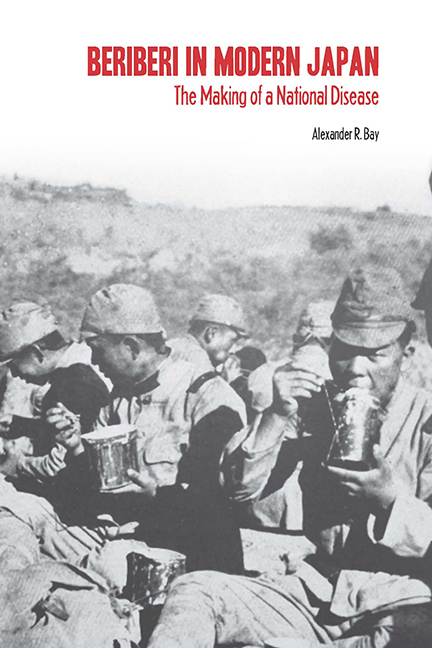Book contents
- Frontmatter
- Dedication
- Contents
- List of Illustrations
- Acknowledgments
- Introduction: Medicine, Power, and the Rhetoric of Empire
- 1 The Geography of Affliction: Beriberi in Edo and Tokyo
- 2 Putting the Laboratory at the Center
- 3 Beriberi: Disease of Imperial Culture
- 4 Empire and the Making of a National Disease
- 5 The Science of Vitamins and the Construction of Ignorance
- 6 The Rice Germ Debate: Total Mobilization and the Science of Vitamins in the 1930s
- Conclusion
- Notes
- Bibliography
- Index
6 - The Rice Germ Debate: Total Mobilization and the Science of Vitamins in the 1930s
Published online by Cambridge University Press: 08 April 2017
- Frontmatter
- Dedication
- Contents
- List of Illustrations
- Acknowledgments
- Introduction: Medicine, Power, and the Rhetoric of Empire
- 1 The Geography of Affliction: Beriberi in Edo and Tokyo
- 2 Putting the Laboratory at the Center
- 3 Beriberi: Disease of Imperial Culture
- 4 Empire and the Making of a National Disease
- 5 The Science of Vitamins and the Construction of Ignorance
- 6 The Rice Germ Debate: Total Mobilization and the Science of Vitamins in the 1930s
- Conclusion
- Notes
- Bibliography
- Index
Summary
At the 1925 Far Eastern Association of Tropical Medicine meeting in Tokyo, the Special Beriberi Committee discussed the possibility of enacting regionwide legislation to regulate rice milling as a means of preventing that disease. Bureau of Public Health technocrat Takano Rokurō, citing several difficulties, argued that it was not feasible to carry out such regulation in Japan. By 1939, the situation had changed. Takano, as the chief of the Ministry of Health and Welfare's (Kōseishō) Department of Public Health and Prevention (Yobō eiseikyokuchō), was involved in a movement to standardize milling to ensure that people received enough vitamin B1. Shimazono Junjirō of Tokyo Imperial University and doctors within the Army Provisions Bureau (Ryōmatsu-shō), through a private organization, the Friends of Food Association (Ryōyūkai), supported a form of white rice that retained most of the vitamin B1–rich rice germ (haigamai). Saeki Tadasu, director of the National Institute for Nutrition Research, advocated instead a form of rice that maintained 30 percent of its rice bran (shichibu tzukimai). Between 1930 and 1940, doctors and nutrition experts argued over the form of this standardized rice. This was called the rice germ debate (haigamai ronsō).
The question of why the government changed its stance needs to be understood within the context of the Second Sino-Japanese War (1937–45). This was a time of total, national mobilization, and both disease prevention and rice conservation became interrelated issues that the state could not ignore. As Yamanouchi Yasushi notes, not only human but also “material resources had to be completely mobilized in order to make war.” William Johnston shows that after public health officials detailed the extent that tuberculosis was threatening Japan's ability to wage war on the continent in the late 1930s, the state began proactively addressing prevention. That is, when state interests were at stake, the government was quick to enact prevention legislation. This explanation holds true for beriberi as well. The main focus of this chapter concerns the story of the 1939 Rice Milling Regulation Law (Beikoku tōseira seigen rei), which legalized a rice standard leaving 30 percent of the rice bran intact. I ask not how beriberi prevention became a state interest warranting national legislation (this is, of course, part of the narrative) but, rather, how Professor Saeki Tadasu, based out of the NINR, broke the fifty-plus-year hold that Tokyo Imperial University Faculty of Medicine professors and army doctors had over beriberi research and prevention.
- Type
- Chapter
- Information
- Beriberi in Modern JapanThe Making of a National Disease, pp. 128 - 151Publisher: Boydell & BrewerPrint publication year: 2012



